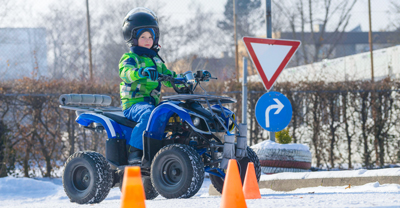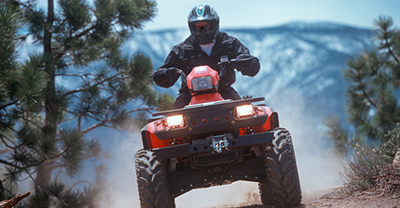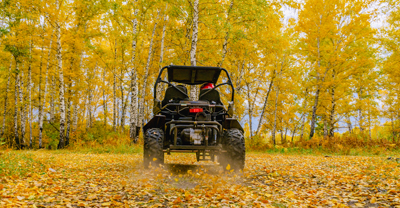ATV safety tips for passengers
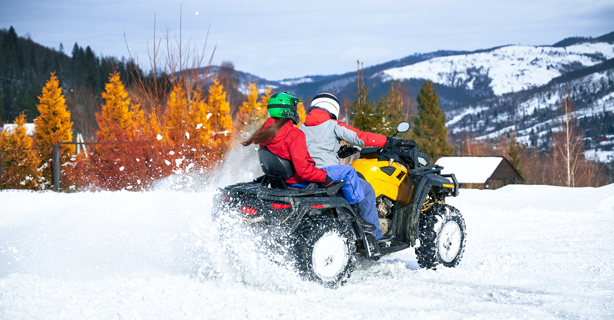
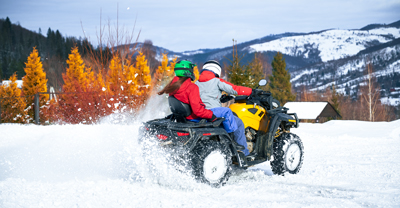
0 min. read
Off-road adventures on ATVs and UTVs are thrilling, but they also come with inherent risks. As ATV-related accidents and fatalities continue to rise, passenger safety is more important than ever.
The Consumer Product Safety Commission (CPSC) reported approximately 130,800 ATV-related injuries treated in hospital emergency rooms across the U.S. in 2020 alone, with an estimated 524 fatalities.* The growing popularity of off-roading underscores the importance of safety measures for both drivers and passengers.
Boost the safety and fun of your off-road adventures by helping prepare your passengers for the ride.

Understanding the ATV passenger’s role
A secure ride relies on more than just the driver’s actions. As an ATV or UTV passenger, your actions directly affect the ride’s safety. It’s important to note the majority of ATVs are designed for a single rider, so if you’re riding as a passenger, ensure the vehicle is intended for more than one person.
Here are some key points to keep in mind:
Strive for stability. Always sit upright and keep your feet firmly on the footrests to maintain the vehicle's center of gravity and help prevent rollovers.
Follow the operator's lead. Communicate with the operator and respond to changes in terrain or speed as directed.
Properly position yourself. On a UTV, sit in your designated seat with your back against the backrest and your seatbelt fastened.
Actively participate. Adjust your body weight to assist in maneuvering, especially on ATVs where leaning into turns is crucial.
Proper positioning for ATV passengers
Your positioning within the vehicle can greatly impact your safety and the ATV’s stability. Different terrains present unique risks. Here are some tips:
Steep hills:

Lean forward to help stabilize the ATV and prevent tipping.
Mud or water crossings:

Shift your weight to assist the driver in maintaining control and be prepared for sudden balance shifts.
Rocky or uneven terrain:

Stay alert for sudden jolts and maintain a strong grip on handholds to avoid being thrown from the vehicle.
Practicing these techniques can help improve your reflexes, making it easier to react to unexpected situations—especially when your adrenaline is high.
Essential gear for ATV/UTV passengers
Safety gear isn't just for drivers—passengers require it, too. Make sure you’re equipped with these must-haves:
Helmet

A DOT-approved helmet is vital for protecting against impacts and flying debris.
Eye protection

Goggles or a face shield protect your eyes from dust, debris, tree branches, and the elements.
Gloves

Riding gloves enhance grip and protect your hands from blisters and abrasions.
Clothing

A long-sleeved shirt and long pants can help protect your skin from scratches and burns.
Boots

Over-the-ankle boots can provide added support and protection.

Communication while off-roading
Clear communication between the passenger and driver can help prevent accidents and enhance the overall ride experience.
Establish hand signals before the ride

Agree on simple signals for "stop," "slow down," "speed up," and "turn left/right."
Practice these signals before starting your ride to ensure clarity.
Use hand signals when engine noise or helmets make verbal communication hard.
Alert the driver to hidden obstacles

Watch for low-hanging branches, hidden rocks, or sudden drops.
Tap the driver's shoulder and point to the obstacle to draw attention.
Speak up if you feel uncomfortable or need a break

Communicate if you feel fatigued, dizzy, or overwhelmed.
Request breaks for rest, hydration, or to adjust your gear.
Be honest about your comfort level with speed or challenging terrain.
Use a communication system for longer rides

Consider helmet-to-helmet communication devices for clearer, constant communication.
These systems allow for easy conversation and immediate alerts without solely relying on hand gestures.
Provide navigation assistance

Use a map or GPS and offer to help with navigation.
Point out upcoming turns or landmarks.
Help track trail markers to ensure you stay on the correct path.
Establish a check-in system

Agree on periodic verbal check-ins, approximately every 15-30 minutes.
A simple "All good?" and "Yep!" can confirm both driver and passenger are comfortable and alert.
Be prepared for emergencies
While you hope for the best, preparing for the unexpected is important. Off-road adventures can take surprising turns, so be ready for anything.
Know first aid
Brush up on your first aid skills or take a wilderness first aid course. At the very least, learn how to treat common off-road injuries like cuts, sprains, and burns.
Pack an emergency kit
Don't hit the trails without a well-stocked emergency kit. Include essentials like a first aid kit, flashlight, multi-tool, duct tape, and emergency blanket. Pack high-energy snacks and extra water—they can make a big difference if you’re stranded.
Understand the vehicle
Familiarize yourself with the basic operation of the ATV. Know how to start, stop, and steer it. And learn how to use any onboard communication or GPS systems.
Review the terrain
Study maps of the area and be aware of local wildlife. Knowing how to handle encounters with wildlife, such as bear, deer, or even snakes, can be lifesaving.
Master navigation
Always be aware of your location. Pay attention to trail markers and landmarks, and learn how to use a compass or GPS device. Personal locator beacons (PLBs) or satellite communication devices can guide emergency help to your location if needed.
Watch the weather
Mother Nature can be fickle. Prepare for sudden weather changes and pack appropriate clothing.
Riding safely: Understanding ATV laws and regulations
To ride safely, it’s essential to know and follow laws governing the use of off-road vehicles (ORVs), from age restrictions and licensing to insurance requirements. Not all ATVs are built for passengers—check your manufacturer's guidelines to confirm the occupancy of your vehicle. Since ATV regulations differ by state, make sure you're familiar with the local rules. Some states even have specific laws about where and how passengers can ride.
Also, as a passenger, knowing your ride has appropriate insurance coverages can help provide peace of mind. There’s protection and assistance in case of accidents, including coverage for liability and medical expenses. Learn more about ATV insurance coverages before your next adventure.
*Data accuracy is subject to this article’s publication date.
The general information in this blog is for informational or entertainment purposes only. View our blog disclaimer.








